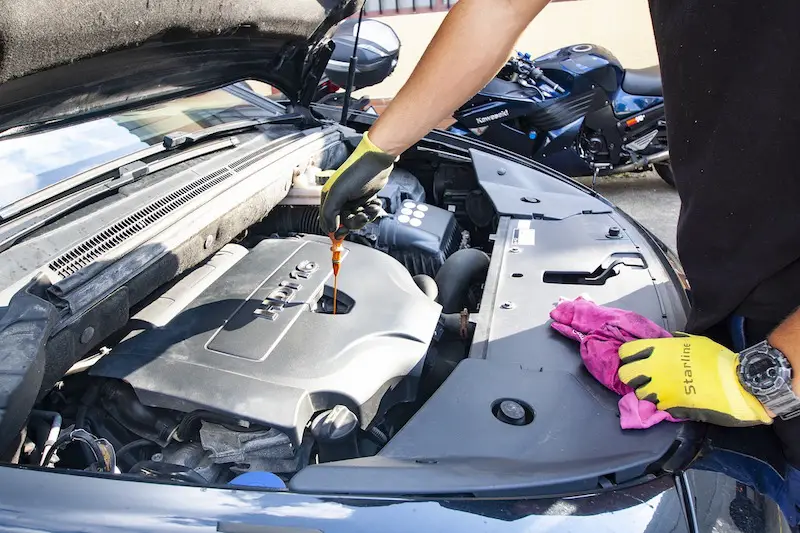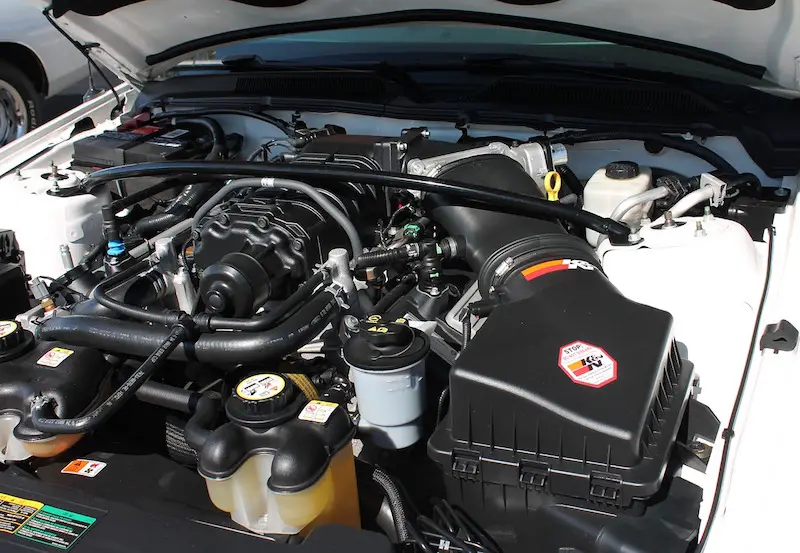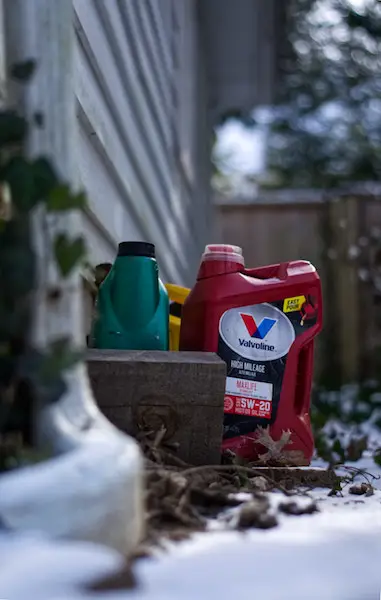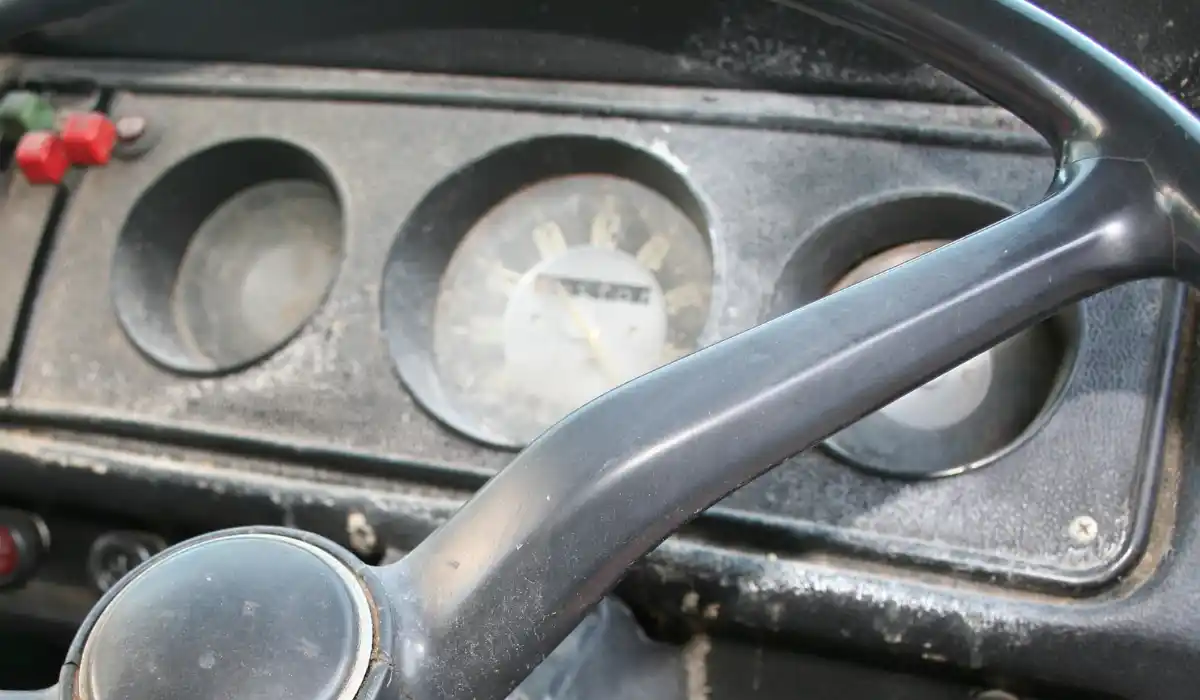
Have you ever wondered how does car engine oil work before? This might have crossed your mind if you do your own basic car maintenance. Or maybe you’re wondering about the internal components of your vehicle.
In this post, we’re going to take a look at the purpose of car engine oil, how it works, and why your vehicle needs oil in the engine. You’ll learn about the main functions of oil as well as how oil is as important as fuel for the performance of your car. Let’s jump right into it!
Jump Ahead To:
What is Engine Oil?
The engine oil found in your vehicle is used as a lubricant. This lubricant helps to move the main components of the engine so that they can work smoothly and efficiently. It also protects these components from corrosion and keeps them at a safe operating temperature.
Engine oil is made up of base stock and additives. These are the two main elements of car engine oil.
Typically, 95% of the oil solution is made from base stock. This comes from petroleum, synthetic chemicals, or a combination of the two. The purpose of the base stock in engine oil is to lubricate the moving parts in the engine and remove any built-up heat.
The remaining 5% of the oil solution is comprised of different additives. These additives are responsible for controlling how thick, viscous, and smooth the oil is. They also help to protect the engine parts against unnecessary wear and tear.
How Does Car Engine Oil Work?
Before trying to explain how a car engine oil works in your vehicle, check out this video down below. This will help to give you a better, more in-depth understanding of what’s going on in a vehicle engine.

After watching the video, you probably have a better idea of the journey that engine oil takes. This is a process that happens every time you start your vehicle and that continues as long as it’s running. Let’s try to break it down in a few more simple steps.
- All of the engine oil action starts in the sump of your vehicle’s engine. This acts as a reservoir for the oil, and is typically known as the oil pan. You can find the oil pan in most vehicles near the bottom part of the engine bay. After turning the engine off, this is where the engine oil is collected. Most vehicle sumps (oil pans) can hold between 3L to 8L (3 quarts to 8 quarts) of oil.
- The engine oil is pumped from the sump. It’s sucked through the pump through the pickup tube where it can be distributed into the engine. This process happens as soon as the engine is turned on. During this process, the engine oil is pressurized for better efficiency and lubrication.
- Before being distributed through the engine, the oil goes through the oil filter. The main function of the filter is to quickly clean the oil, getting rid of any impurities, dirt, and debris. Filters also remove any contaminants that can possibly damage the engine. Clean oil and a properly functioning filter ensures the engine runs as efficiently as possible.
- After running through the filter, the oil is distributed throughout the engine. Critical engine components, such as the valve train, pistons, and bearings are lubricated. The oil continues cycling through the engine as long as the vehicle is running.
- When the vehicle is turned off, the oil returns to the sump near the bottom of the engine. At this point, the oil is no longer cycling through the engine. It will remain collected in the sump until the next time the engine is turned on.
To sum it up, the engine oil keeps critical engine components properly lubricated. The oil is designed to coat moving parts and prevent excessive friction between the different engine components. It also helps to clean dust and debris that can build up in these moving parts, and prevents it from building up to a dangerous level. These factors make car engine oil and essential parts of efficiently and safely running an engine.
What Does Car Oil Do?

By now, you have a better idea of how car engine oil works. It’s also a good idea to learn what does car oil do exactly. For example, why do you need car oil in the first place? Let’s take a look at what car oil does for your vehicle’s engine.
Reduces Friction
One of the main purposes of car engine oil is to reduce friction in the engine. The engine is comprised of a variety of different metal components. These different components typically rub together, which creates friction and heat.
This friction and heat makes it difficult for the metal parts to continue rubbing together efficiently. Without sufficient lubrication, these metal parts can become damaged or overheat to a critical point.
Engine oil acts as a lubricant that’s designed to reduce friction and heat. With oil, there is less metal-to-metal contact and the metal parts are able to work more efficiently. Without oil, car engines can become critical damage in a short period of time.
Reduces Wear and Tear
All of the moving and rubbing components in the engine are subject to wear and tear. Eventually, most engine components will need to be replaced.
With proper lubrication from the car engine oil, these parts can work more efficiently. This reduces the wear-and-tear and helps to increase the lifespan of important to engine components.
Neglecting regular oil changes, or increase in the interval between oil changes, can increase the wear and tear in your engine. This will cost you more money in the long run. Parts will have to be replaced more often and it’s possible for the engine to suffer critical damage.
Reduces Harmful Deposits
Whenever you drive, debris, dust, particles, and other harmful deposits are introduced into your engine. These can interfere with the performance of your engine, if they’re not properly managed.
The engine oil in your vehicle acts as a filter and absorbs any of the impurities making their way into the engine. That’s why it’s important to regularly change the oil and oil filter to avoid any issues with performance.
Different Types of Engine Oil

There are a number of different types of engine oil available for cars and different vehicles. Each offers their own benefits and drawbacks, depending on your engine and driving style. Typically, you’ll find two main types of engine oil – mineral and non-synthetic.
Mineral Oil
Mineral oil is the most common type of engine oil. It’s made from petroleum, or from a byproduct of petroleum. Mineral oil is better suited for entry-level, budget cars that don’t have sophisticated engines. It’s also a good choice for drivers on a budget that don’t want to spend a lot of money on oil changes.
Mineral oil is generally more affordable, but doesn’t offer the same benefits as synthetic oil. Typically, it doesn’t last as long and isn’t as capable of withstanding extreme temperatures as the synthetic alternative.
Synthetic Oil
Synthetic oil is made in a factory using a blend of different synthetic chemicals. When it comes to the best car engine oil, you’re better off going with synthetic oil.
This oil type is more popular for mid-range and luxury vehicles. While it is more expensive, it offers better lubrication and will last longer than mineral oil. It’s synthetic oil that I would recommend for your own vehicle oil changes.
When Should You Change your Oil?

As someone that drives a vehicle regularly, knowing when to change your oil is important. While you probably want to avoid any unnecessary expenses, oil changes are something that shouldn’t be ignored. As always, referred to your vehicle’s maintenance schedule to find the best oil change intervals.
Apart from that, there are some basic guidelines you should follow regarding when you should change your oil. If you’re not able to do your own oil changes, there are typically local garages that offer reasonable prices with their own oil change service.
Today, modern vehicles can easily drive between 5,000 and 10,000 miles before needing an oil change. This is due to the upgraded engine designs as well as the better quality oils that are currently available. Using a full synthetic oil, you’ll be able to drive even longer before needing an oil change.
If you’re not someone that tracks your vehicle maintenance, here are some things to look out for that will let you know it’s time to change the oil in your vehicle:
The Oil is Already Black
It’s a good idea to regularly check the levels, as well as the color, of the oil in your engine. This is done by pulling out the oil dipstick and inspecting the oil. There are tutorials online or you can refer to your owner’s manual for a step-by-step guide on how to check your oil.
Looking at the oil on the dipstick, it should be a semi translucent or somewhat dark color. If the oil is already black, you’ll want to change the oil immediately. This is a sign that the oil is dirty and should be replaced. Ignoring an oil change will overload the filter and have a negative impact on your engine’s performance.
The Engine Sounds Different
If you’re someone that’s driving a lot, you probably know how your engine normally sounds. Should you notice any different sounds, consider changing the oil right away. This is one of the first places to start whenever you run into any engine issues, especially different noises.
After an oil change, if the engine still doesn’t sound the same, consider bringing your vehicle to a local mechanic. When it comes to maintenance, preventive action is the best way to avoid any unnecessary or expensive problems.
Low Oil Levels
As we just mentioned, inspecting your oil levels on a regular basis is important for preventive and ongoing maintenance. Pull up the dipstick and check the current oil level. If it’s near the bottom of the gauge, it’s time to replace the oil.
Some higher-end, modern vehicles will have oil change intervals built into the on board computer. You should be able to access this information to see how long is remaining until you need to change the oil.
When the Engine Oil Light Comes On
You never want to wait long enough for the engine oil light to show up on your dashboard. If the engine oil light does turn on, you need to change the oil immediately. as always, follow the maintenance schedule in your owner’s manual to avoid any issues.
Following Maintenance Schedule Intervals
Following the recommended intervals in your maintenance schedule is the best course of action when it comes to car oil changes. Generally, what’s a good idea to replace the oil every 5000 miles or every six months, depending on what comes first.
Those of you with short, local commutes will need to take more preventive action. People with longer, highway-speed commutes can enjoy a longer interval between changes.
It’s a good idea to do your own oil changes if you want to save money and learn how your vehicle works. Otherwise, take the time to bring your vehicle into your local mechanic for any inspections or changes that need to be made.
Why Are Oil Changes Important

By now, you’re probably wondering why are oil changes important. For starters, engine oil isn’t something that lasts forever. Eventually it begins to break down and lubricate less efficiently. The engine oil filter will get clogged with contaminants and will need to be replaced.
Neglecting to replace the oil and filter when necessary can lead to serious issues with your vehicle’s engine. Old, dirty oil won’t keep the engine parts moving as efficiently. Debris, dust, and other particles that aren’t filtered can also get stuck in your engine.
To keep your vehicle running in tip-top shape, it’s of the utmost importance to follow the maintenance schedule when it comes to oil changes. This is something you could easily do at home. Otherwise, bring your car to your local mechanic and have them do it for you. With regular oil changes your car will be running smoothly and efficiently as long as it’s properly maintained



